Searching for a Cure
The Untimely Death and Exemplary Life of Albert E. Schrockby Donna Schrock Birkey
Originally published in the Winter 2013 issue (Vol. XXXX • No. 4)
Illinois Mennonite Heritage Quarterly (http://www.imhgs.org) (Used with permission of original publisher)
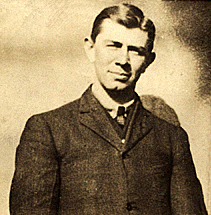
Albert Elmer Schrock
Albert Elmer Schrock (1886-1917)
Timeline of Albert’s life:
1891 Albert’s family moved to Champaign County from Tazewell County when he was five years old.
1898 Joseph Yordy family moved to Fisher when Josephine was five years old.
1907 Josephine became Albert’s wife. They were both 21 years of age. The couple lived in a house one mile east of Fisher.
1909 Albert and Josephine moved to a farm two miles south of Fisher in Newcomb Twp., where Elmer was born in that same year, then Orval in 1910.
1910 Albert contracted tuberculosis.
1911/12 The couple had a farm sale, moved with their children to Colorado for Albert’s health.
1915 The family had returned to Fisher to a house Albert’s father built for them.
1916 Josephine became pregnant with daughter Eunice.
1915/16 Albert spent some months in Ottawa, Illinois at a tuberculosis sanitarium.
1917 Albert died January 9 and Eunice was born June 25.
Albert’s Death
There was no Christmas tree adorning the farm home of Albert and Josephine Schrock just north of Fisher, Illinois, on Christmas morning 1916, but there were many presents on the dining room table, including a few toys for their two boys Elmer and Orval. In more than one way it was not a normal Christmas for the family.
For six years Albert had been fighting tuberculosis. The dreaded disease has been called consumption, because it seemed to consume people from within, with a bloody cough, fever, pallor, and long relentless wasting. There is a slight difference between the two terms however, since consumption is considered the terminal stage of tuberculosis.[1]
When a youth of fifteen, Albert contracted the measles. As so often happened, the disease left him with some physical disability. His lungs were weakened and as a result his health after that was tenuous. It was a matter of debate, but generally accepted that measles had a direct influence in making a person vulnerable to contract tuberculosis.
If Albert was like most tuberculosis patients, he experienced flushed cheeks, bright eyes, fever, loss of appetite, and of course the cough. The disease, after contracted, can remain dormant for long periods of time without causing symptoms, but if the immune system of the person becomes weakened it can reactivate and cause infection in the lungs and other parts of the body.[2]
Albert was a good student and while suffering the weakness of tuberculosis he spent much time reading books and studying the Bible. He was patient in his suffering, but fought hard to rid himself of the disease.
In 1904 in Denmark a charity first raised funds for tuberculosis patients. America adopted the
idea in 1907.[3] About 1905 the state of Colorado touted, “It is a fact, well known and recognized by the medical fraternity that the climate in this section of the state is the most beneficial to those suffering from tuberculosis or asthmatic affections of any climate found in the United States. Plenty of pure air, sunshine and mild temperatures are the climactic essentials in the treatment of the tubercular patients and there are to be found in abundance in this part of the Arkansas Valley.
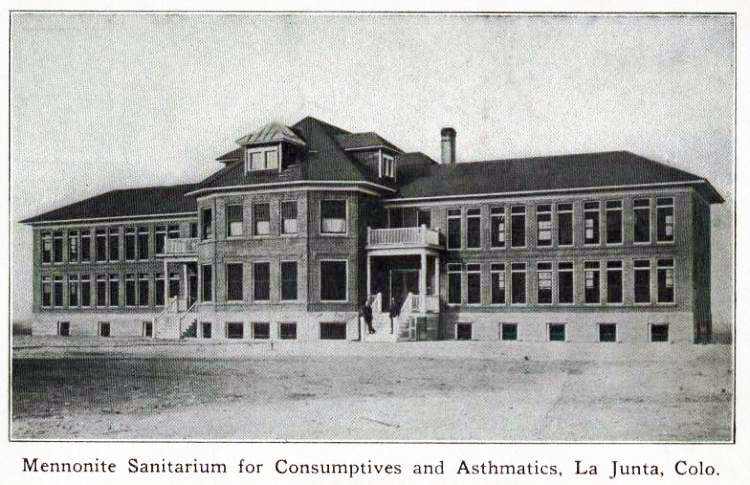
Mennonite Sanitarium in La Junta, CO
“At the same time The Mennonite Church was thinking of establishing a sanitarium for the treatment of tuberculosis in about the same area—not far from La Junta, high on a hill above Arkansas Valley. The idea met with a hearty response, and by the 25th of October of 1905 the building was ready for dedication and the reception of 38 patients. ” [4]
It was near the sanitarium in La Junta that the entire family lived for some time. But before leaving Illinois about 1911, a sale was held at the farm south of Fisher, selling the couple’s farm equipment and livestock. The sale included a brown mare bred to Reardon’s Percheron horse. The Percheron was the breed of choice at the time among Mennonites of the area. [5]
Eventually, Albert’s illness was said to be “arrested,” and by 1915 the family was back in Illinois living on his family’s farm where Albert’s father had built a house, barn, chicken house and coalhouse, just a quarter mile from his own home. The house was built with special windows that would open outward to allow the healing fresh air into the home.” [6]
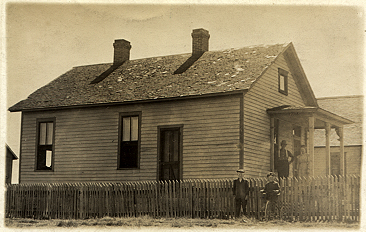
Schrock home in Colorado–Albert and Josephine on porch, Elmer and Orval standing by the fence
Since there were other possibilities for treatment nearer to home, it was decided to take advantage of one of them. Dr. W. J. Pettit of Ottawa, Illinois, one of two pioneer physicians in Illinois who spent his life fighting the illness tuberculosis, opened the Ottawa Tent Colony for treatment of tuberculosis in 1904. In medical journal article it was “demonstrated beyond all doubt that tuberculosis can be cured in Illinois quite as easily and successfully as anywhere else… Treatment consists in out of door life, a carefully selected diet, regulations of exercise and mediation for the improvement of nutrition. Each patient is expected to take no less than three quarts of mild and six raw eggs a day, in addition to the regular meals.”[7]
The alternative facility was in in Winfield, Illinois—Zace Tuberculosis Sanatorium—but Albert chose the Ottawa Tent Colony. He spent several months there during 1915-1916, with the family visiting him occasionally.
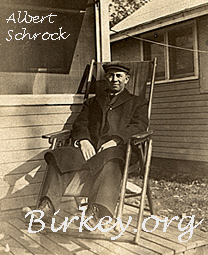
Albert relaxing in Ottawa.
Dr. John Colwell, a Foosland doctor, saw Albert a number of times between May 1915 and December 1916, when Dr. Colwell visited the home two days before Christmas. For some time prior to Christmas Albert had been feeling unusually well. He and Josephine must have hoped their prayers and cutting-edge treatment plan was working. Perhaps the worst was over. Josephine especially prayed that Albert was on the mend for she was three months pregnant. But just two days after the family had attended church together, on the cold morning of January 9, 1917, Albert kindled a fire in the stove very early in the morning to warm the house. Not long after, he experienced a pulmonary hemorrhage as a result of the tuberculosis, and died a short time later—just a few days before his 31st birthday.
Josephine, always calm, was no doubt a stabilizing influence for their two boys as she cared for Albert in his last months. Much later in life she would also be of great help to her son Elmer’s four young children as his wife struggled with cancer for two bedfast years before her death in 1951.
When Albert, a member of the Amish Mennonite community near Fisher died, Julius Unzicker was called to “lay out the body” of the deceased. The body was washed, dressed, and placed in the coffin. Mary, his wife, no doubt presided over meals for the family, and for friends and relatives who would come to the house to offer condolences. Several of the men relatives sat up with the body throughout the night until the visitation the following day. In the Amish tradition, Julius asked Josephine what persons the family wanted as pallbearers and singers, and any other funeral details. He then passed the information on to Lamb Funeral Home in Gibson City who cared for the embalming process and the purchase of a casket. Another decision Josephine and her family had to make was which team of horses would pull the open seated wagon hearse from the house to the church and then from the church to the cemetery one fourth mile west—the black team, or the bay team.[8]
The following day, a cold snowy January Thursday, the funeral was held at the East Bend Amish Mennonite Church. Samuel Gerber, a minister from Morton, preached the funeral sermon. Samuel was well known to the Schrock family from their days living in Tazewell County and was a participant in several Schrock funerals. After the casket was loaded into the hearse, one of Julius’ sons drove the team to the cemetery located on land donated to the church by Albert’s grandparents, Andrew and Veronica Sutter Birky, some twenty years before. “He [Julius’ son] would have been dressed in a full-length coat made of heavy horsehide with matching hat and gloves with long, elbow-length cuffs. The coat had wooden toggle buttons that were fastened shut by rope loops.
[9]
Many years later my father Orval reminisced of Christmas 1916, “I think my parents had a feeling that it would be our last Christmas together as a family and, sure enough, fifteen days later on January 9, my father died of tuberculosis. The day of the funeral was very cold and snowy and I remember the black horse-drawn hearse with the driver sitting out in the open.”
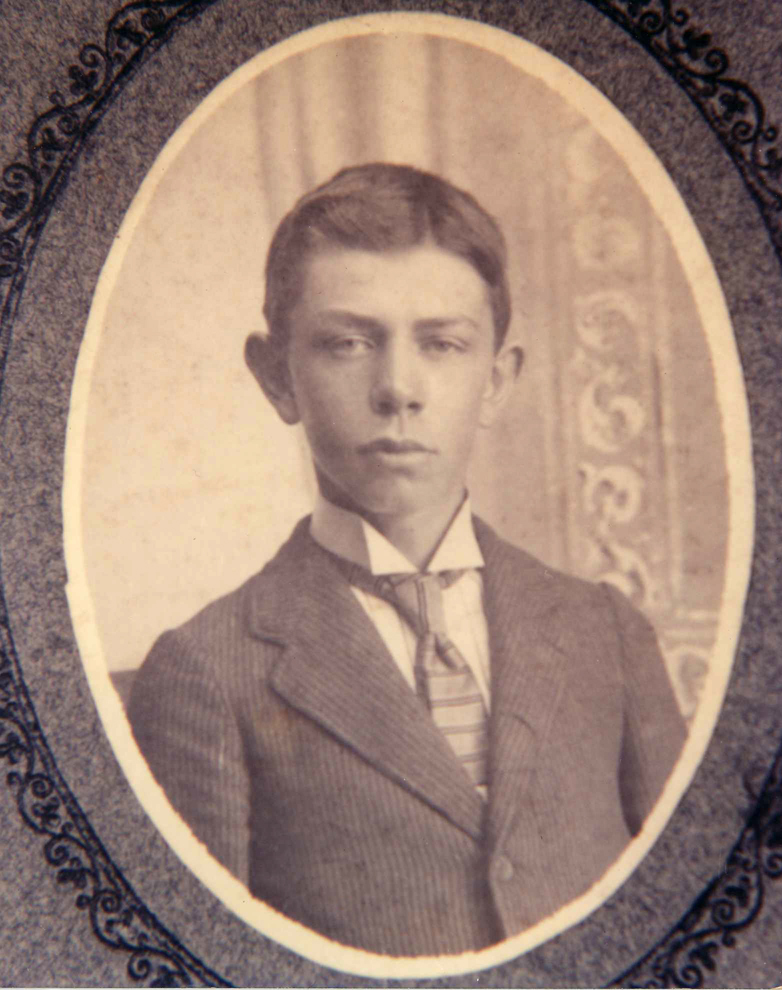
Albert as a young boy
Albert’s Earlier Life
Albert Elmer was the son of John and Mary Schrock. His only sibling was a sister, Fannie. The family lived on a farm two miles north and one mile west of Fisher in a house built by his father, John Schrock. When Albert was not attending school he helped with farm chores.
As a child, Albert and his sister, Fannie, attended Brown School not far from their home. It was a one-room school, and their father, John Schrock, was on the school board overseeing the education of the group of farm children attending.
Albert joined the Amish Mennonite Church when 17 years of age. He was a deep thinker and chose to be right rather than popular. He served for a time as superintendent of the Sunday school that was organized in 1892. He was even considered a candidate for minister of East Bend Amish Mennonite Church, but the lot fell upon Joseph A. Heiser, his brother-in-law.
The Joseph Yordy family had moved from Flanagan to Fisher about 1890 and remained there until 1911. They lived a few miles away from the Schrock family and also attended East Bend Amish Mennonite Church where daughter Josephine was baptized by John C. Birky in 1901.
Years later, at the Joseph Yordy Reunion in June 1978, brother Alvin Yordy made the following remarks: “Josephine was a second mother to me. Her husband, Albert Schrock died of tuberculosis about ten years after their marriage. She reared with great love and care, her three children. Her organizational ability was recognized in her community and church. She, too, was service-oriented, helping many families through difficult times. She helped much in the homes of her own children when Elmer lost his first wife and she was the one who cared for Eunice’s family while she was pursuing her professional career as a teacher. Several of her brothers remember well how she washed our ears before going to church.”

Josephine in 1917, after the death of Albert and the birth of Eunice. Elmer to the left and Orval to the right
Since the Yordy and Schrock families spent time together it was natural that the handsome but frail Albert would woo and win the heart of Joseph’s oldest daughter. Albert and Josephine were married in 1907 in the Yordy home by Bishop Peter Zehr. [10]
The couple’s first home was a small house along the railroad tracks one mile east of Fisher. It was later torn down. By 1909 they were working a farm south of Fisher and while living there two boys were born—Elmer in 1909 and Orval in 1910. It was this farm they vacated in about 1911/12 when Albert, Josephine and two small boys packed their personal belongings and traveled to Colorado with hope and prayers that the dry climate would give better health to Albert.
But that was not to be.
Newspaper Article
Fisher, Jan. 9–(Special.)–Albert Schrock, well-known resident of this community, died this morning at his home, two miles north of the village, after an illness of four years, due to tuberculosis. He had been unusually well of late and arose this morning and kindled a fire and shortly afterward was seized with a hemorrhage and died a short time afterward. The deceased was a son of John and Mary Schrock and was born on January 13, 1886. He was married about eight years ago to Miss Josephine Yordy, who, with two sons, Elmer and Oliver (sic, Orval), survive, as do also his parents. A sister also survives. He was a prominent member of the Amish church. The funeral will be held on Thursday from the Amish church, Rev. Samuel Gerber, of Morton, conducting the services. Burial will be made in the family lot in the Amish cemetery.
Obituary: Jan 25, 1917 Gospel Herald
Schrock. – Albert E. Schrock was born in Tazewell Co., Ill., Jan. 13, 1886; died at his home near Fisher, Ill., Jan. 9, 1917; aged 30 y. 11 m. 27 d.
He united with the Amish Mennonite Church at the age of 17 years and remained faithful unto the end. He united in marriage with Dec. 18, 1907. To this union were born 2 sons, Elmer and Orval who with his loving wife, are left to mourn his early departure, also father and mother, 1 sister, an aged grandmother, and a host of other relatives and friends. He was a very devoted Christian, living true to his convictions. He was elected superintendent of the Sunday school where he served faithfully until his health failed, when he was attacked with the dreaded disease, tuberculosis, of which he was a sufferer for four years. Much of this time he spent in reading good books and studying God’s Word. He bore his afflictions patiently and fought the disease hard, and died with a hemorrhage. He was a deep thinker, very conservative, choosing rather to be right than popular.
Even with his afflictions he always took an active part in church work, being in Sunday school two days before his death.
Funeral services were conducted Jan. 11 at the East Bend A. M. Church by Bro. Samuel Gerber of Pekin, Ill., assisted by the home ministers. Buried at the Mennonite cemetery.
Fare thee well, our brother,
Yes, a last and sad farewell,
But in heaven, we’ll try to meet thee,
And with thee forever dwell.
ENDNOTES
[1] Since about 1950 the two words have been used synonymously. The disease has also been called the “white plague.”
[2]http://www.medicinenet.com/tuberculosis/article.htm
[3] http://www.news-medical.net/health/History-of-Tuberculosis.aspx)
[4]http://gameo.org/index.php?title=Mennonite_Hospital_and_Sanitarium_%28La_Junta,_Colorado,_USA%
[5] Illinois Mennonite Heritage Quarterly, “Amish Mennonite Stock Management, 1860s-1920s,” Debra A. Reid, Vol. XXXIV, No. 1, Spring 2007, P. 10.
[6]Alta Heiser Detweiler, typed memories. Date unknown.
[7] The Ottawa Tent Colony for Treatment of Tuberculosis. Editorial Comment excerpted from Wisconsin Medical Journal, 1904; (3) 7:410-412.Arthur J. Patek, AB, MD, Editor
[8] Changing Funeral Practices and the Lives of Julius K. (1864-1961) and Maria (Mary) Oesch Unzicker (1869-1928) by Kathryn Cender Martin. Illinois Mennonite Heritage Quarterly, Vol. XXXVIII, No. 3, Fall 2011.
[9] Ibid.
[10] Albert and Josephine were second cousins. Their common ancestor was Christian Birki (Birky) and Maria Anna Gascho (https://birkey.org/wc01/wc01_219.html), whose daughter Mary married Peter Yordy in 1847. Mary was known for her “pap” given to sickly infants with feeding problems and perhaps that is one reason two of her granddaughters, Anna and Josephine Yordy, were also known for their semi-professional nursing skills.
